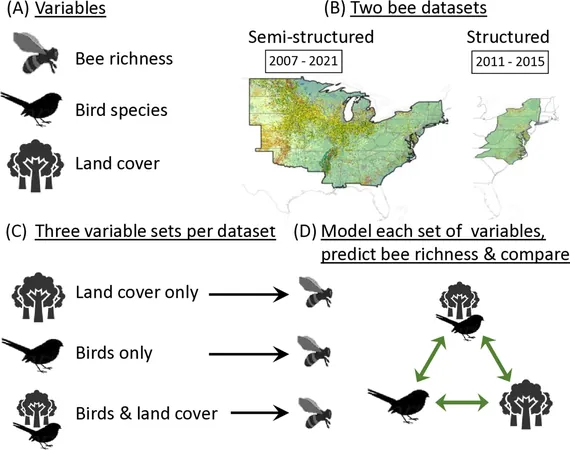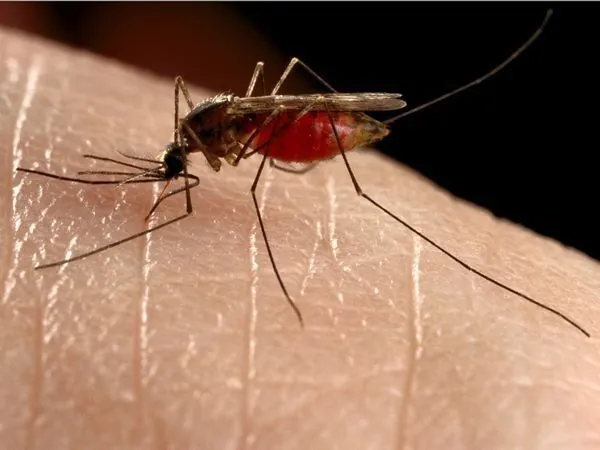
Unlocking Bee Populations: How Bird Data Enhances Wild Bee Estimates
2025-04-25
Author: Emma
Birds and Bees: A Critical Conservation Connection
A groundbreaking study published in PLOS One shines a light on wild bee populations, revealing that combining bird observation data with land cover information offers a far more accurate picture of wild bee species richness than relying on either dataset alone.
Why Bees Matter More Than Ever
This new insight is crucial as wild bees face dramatic population declines, threatening both ecosystem health and agricultural productivity. Unlike honeybees, which are cultivated by beekeepers, wild bees play an independent but vital role in pollination.
The Research Behind the Revelations
Led by scientists from the Cornell Lab of Ornithology and the Cornell Atkinson Center for Sustainability, the study aims to bridge the existing data gap regarding wild bee populations across the United States. Josée Rousseau, the lead author, highlights that insufficient data hampers conservation planning for these essential pollinators.
A Novel Approach Using Bird Insights
To better understand bee populations, the team utilized bird data from eBird, a widespread program where birdwatchers log their observations. Amanda Rodewald, faculty director at the Cornell Lab, notes that birds serve as excellent ecological indicators, often revealing environmental quality insights that satellite imagery cannot.
Innovative Data Combinations Yield New Answers
By merging bird data with publicly available land cover data, the researchers could predict wild bee species numbers more effectively. They analyzed an impressive 476,584 bee records across 792 species and correlated these with 79 bird species and USDA land cover data. The results confirmed the superior effectiveness of combining these data sources.
Ecological Indicators: Birds Leading the Way
Rodewald emphasized that both birds and bees respond similarly to environmental features, even if at different scales. For instance, specific bird species like the Gray Catbird and Orchard Oriole can indicate the presence of flowering plants that support bee populations.
Regional Insights for Tailored Conservation
The study found that bee richness tends to be higher along the East Coast and in the Appalachian Mountains, while Midwestern agricultural areas populated by monocultures lag behind. This varied distribution suggests that conservation strategies need to be adapted based on regional specifics—some areas may need habitat protection, while others require restoration efforts.
Broader Implications for Sustainability Efforts
According to Patrick Beary, senior director of Strategic Partnerships at Cornell Atkinson, this research has sparked interest from conservation organizations, local communities, and corporations committed to sustainability initiatives. The tool developed from this study aims to answer crucial questions about where to focus pollinator conservation efforts and whether those efforts truly benefit bee populations.
Conclusion: A New Era of Conservation Collaboration
As this study paves the way for more informed conservation strategies, it underscores the interconnectedness of wildlife and the importance of every piece of data in protecting our pollinators. Understanding the relationship between birds and bees could just be the key to safeguarding both for future generations.









 Brasil (PT)
Brasil (PT)
 Canada (EN)
Canada (EN)
 Chile (ES)
Chile (ES)
 Česko (CS)
Česko (CS)
 대한민국 (KO)
대한민국 (KO)
 España (ES)
España (ES)
 France (FR)
France (FR)
 Hong Kong (EN)
Hong Kong (EN)
 Italia (IT)
Italia (IT)
 日本 (JA)
日本 (JA)
 Magyarország (HU)
Magyarország (HU)
 Norge (NO)
Norge (NO)
 Polska (PL)
Polska (PL)
 Schweiz (DE)
Schweiz (DE)
 Singapore (EN)
Singapore (EN)
 Sverige (SV)
Sverige (SV)
 Suomi (FI)
Suomi (FI)
 Türkiye (TR)
Türkiye (TR)
 الإمارات العربية المتحدة (AR)
الإمارات العربية المتحدة (AR)